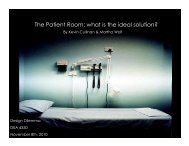The role of physical design and informal communication
The role of physical design and informal communication
The role of physical design and informal communication
You also want an ePaper? Increase the reach of your titles
YUMPU automatically turns print PDFs into web optimized ePapers that Google loves.
Meetings were held over a three month period prior to commencing formal data<br />
collection with the nurse manager <strong>and</strong> CNS to gain insight into the graduate nurse<br />
orientation period <strong>and</strong> the daily operations <strong>of</strong> 6N. Additionally, the researcher<br />
received her own <strong>informal</strong> orientation <strong>of</strong> the unit as she spent several short periods <strong>of</strong><br />
time on the floor with the CNS. During these periods, the CNS introduced staff<br />
members, noting their title <strong>and</strong> <strong>role</strong> on the unit, <strong>and</strong> also commented on how staff use<br />
the space.<br />
2.6.1 Clinical Work Measurement (CWM) Tool<br />
<strong>The</strong> CWM tool, developed by the Health Informatics Research & Evaluation<br />
Unit (HIREU) at <strong>The</strong> University <strong>of</strong> Sydney in Australia, uses multi-dimensional work<br />
classifications for measuring the work patterns <strong>of</strong> doctors, nurses <strong>and</strong> pharmacists.<br />
<strong>The</strong>se classifications are programmed into h<strong>and</strong>-held PDAs equipped with specially<br />
developed s<strong>of</strong>tware. An observer follows individual clinicians for periods <strong>of</strong> up to 2<br />
hours as they undertake their daily work tasks. During this time, a PDA is used to<br />
collect information about work tasks (eg. what they are doing), as well as information<br />
about who is involved in the task <strong>and</strong> how the task is being completed (eg. with a<br />
telephone, computer, etc). Additionally, the tool allows the observer to capture<br />
interruptions <strong>and</strong> multi or parallel tasking as well as the distribution <strong>of</strong> clinicians’ time<br />
across work tasks.<br />
A major purpose <strong>of</strong> the study was to investigate ways in which the <strong>physical</strong><br />
layout <strong>of</strong> the unit affects interaction patterns, yet the original CWM program was not<br />
<strong>design</strong>ed to collect data on the location <strong>of</strong> interactions. Consequently, the existing<br />
pre-programmed “how” category, which recorded information on how the task was<br />
executed, was replaced with a “location” category (see Appendix D for modified<br />
categories). This change allowed the researcher to record where on the unit each<br />
32







